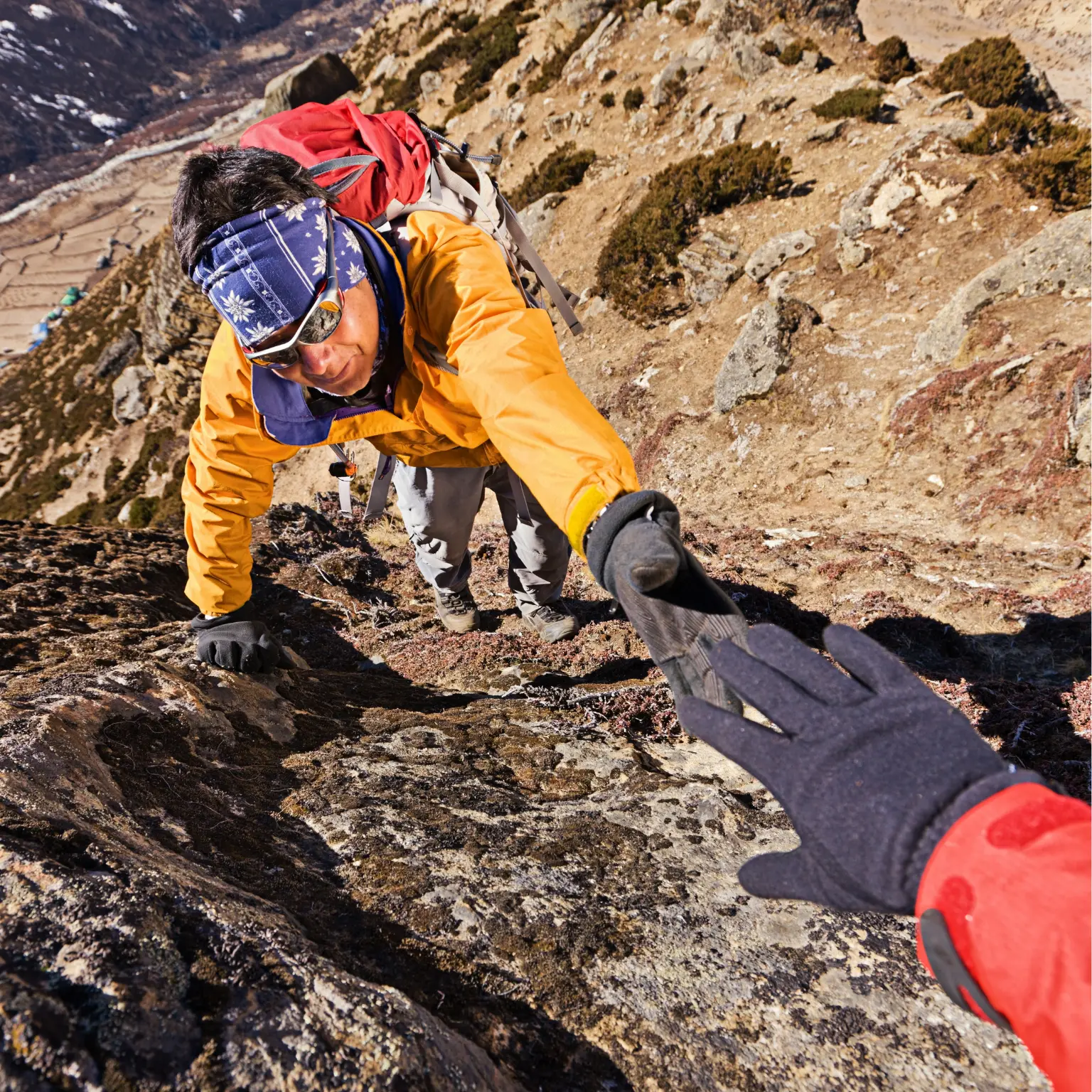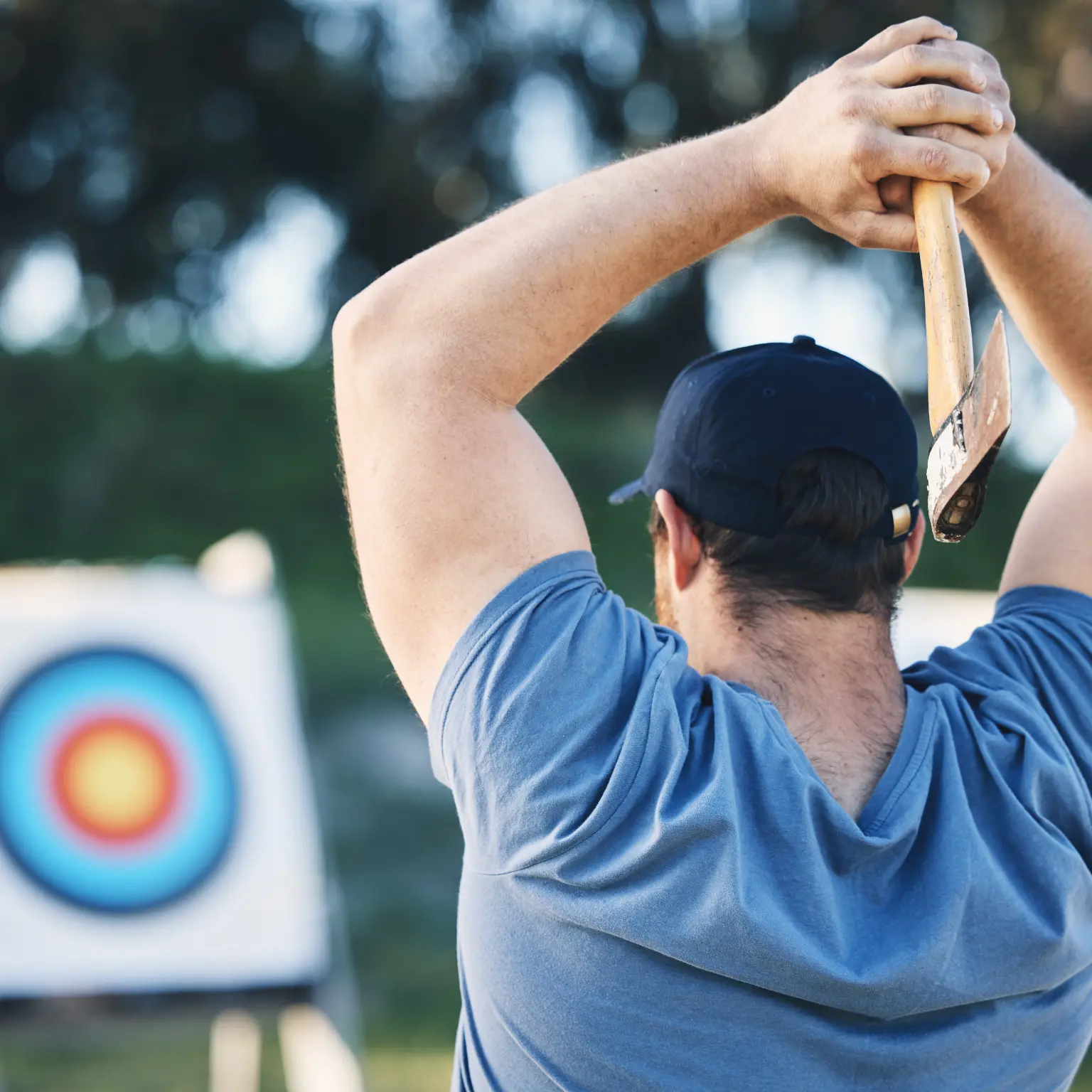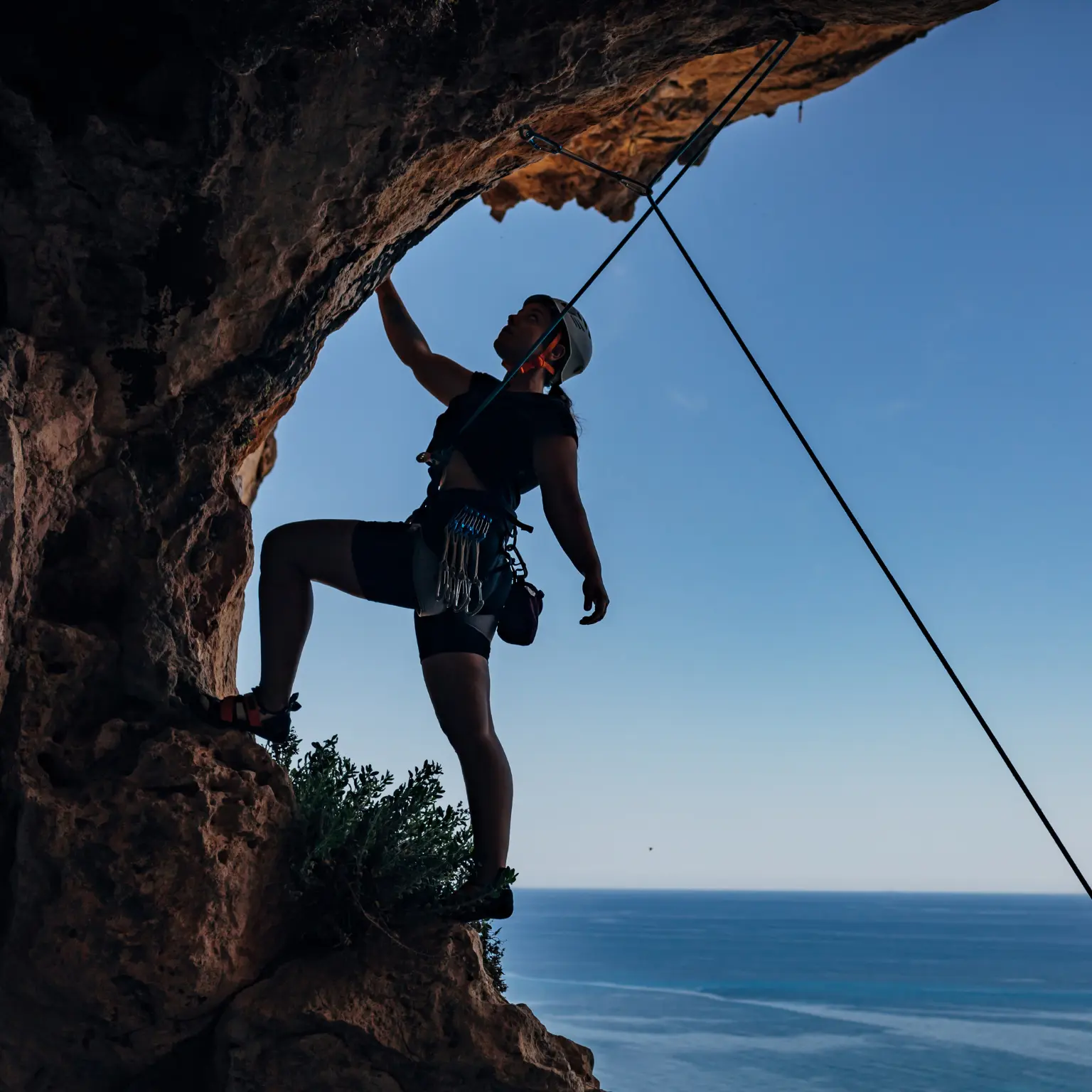7 Essential Tips for Safe and Thrilling Outdoor Rock Climbing
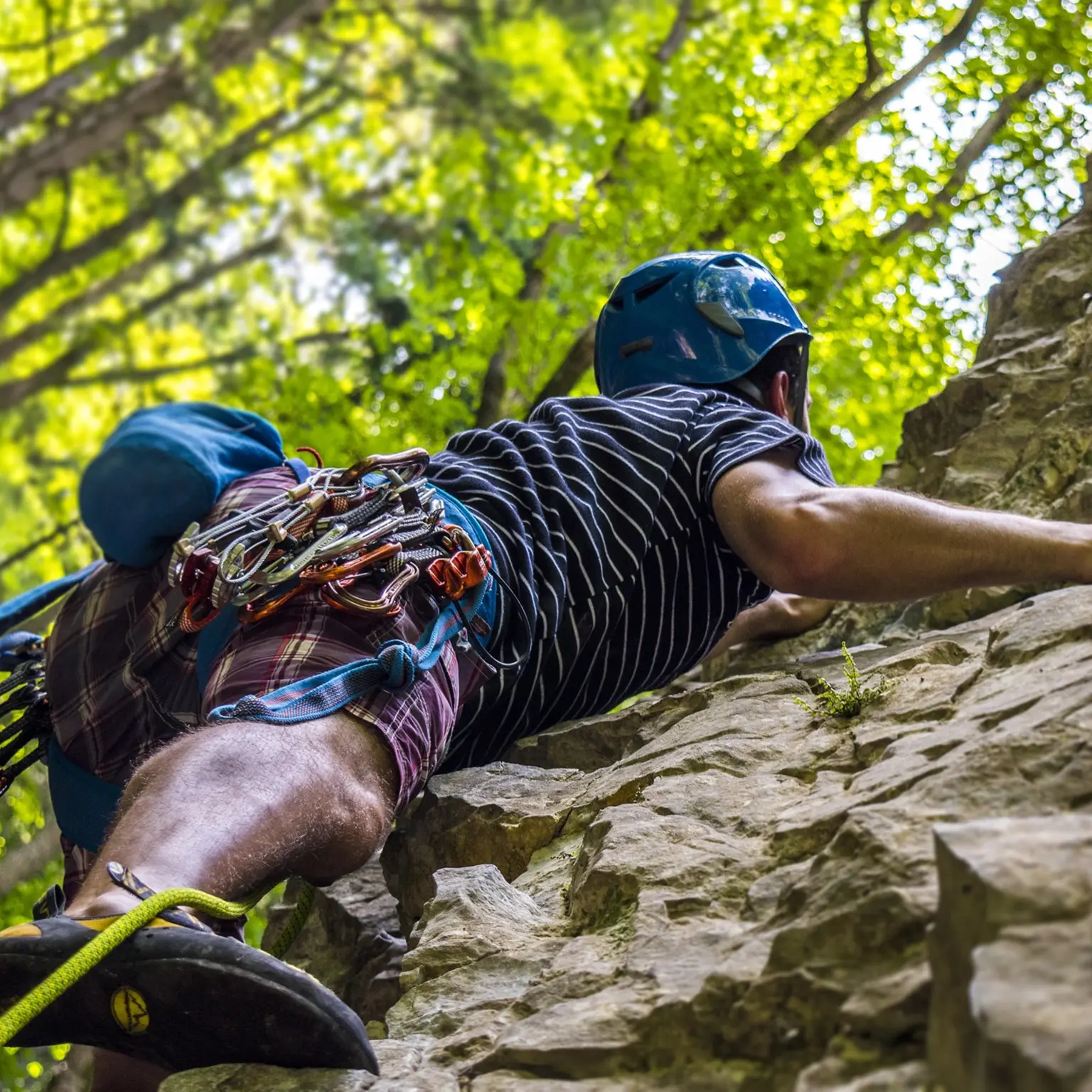
Welcome to Healthy Stride Wellness! Have you ever dreamt of scaling a majestic rock face, feeling the wind whip through your hair as you conquer new heights? Outdoor rock climbing offers a unique blend of physical challenge, mental focus, and breathtaking scenery. It’s no surprise this adventure sport is rapidly gaining popularity!
But before you embark on your first climb, it’s crucial to prioritize safety and ensure a thrilling (not terrifying) experience. Here at Healthy Stride Wellness, we’re passionate about empowering you to enjoy healthy activities with confidence. That’s why we’ve compiled this comprehensive guide packed with 7 essential tips for safe and exhilarating outdoor rock climbing.
Table of Contents
Key Takeaways
- Safety First: Mastering basic safety protocols is paramount before even touching a rock face.
- Find Your Perfect Climb: Not all climbs are created equal! Choose a path that suits what you’re good at and what you enjoy.
- Embrace the Challenge: Rock climbing is a journey, not a destination. Focus on progress, celebrate small victories, and enjoy the learning process.
7 Essential Tips for Safe and Thrilling Outdoor Rock Climbing
Now, let’s dive into the heart of this guide! Here are 7 essential tips to ensure your outdoor rock climbing adventure is both safe and exhilarating:
Prioritize Safety: Knowledge is Power
- Seek Professional Instruction: This is the golden rule, especially for beginners. Enroll in a rock climbing course led by a certified instructor. They’ll guide you through essential safety protocols, proper climbing techniques, and equipment use. Learning the fundamentals under expert supervision will equip you with the confidence and skills to tackle outdoor climbs safely.
- Master Belay Techniques: Belaying involves securing your climbing partner with a rope system. Mastering proper belay techniques is crucial as it ensures your partner’s safety in case of a fall. Practice belaying extensively under the guidance of your instructor until it becomes second nature.
- Gear Up Properly: Invest in high-quality climbing gear that fits you well. This includes a harness, climbing shoes, helmet, belay device, locking carabiners, and dynamic climbing rope. Never compromise on safety by using worn-out or ill-fitting equipment.
- Buddy Up: Rock climbing is inherently a social activity. Never attempt to climb outdoors activities alone. Always climb with a trusted partner who has also received proper training and possesses belaying skills. This ensures you have someone to support you and vice versa in case of emergencies.
- Communicate Clearly: Clear and concise communication is essential during a climb. Establish hand signals and vocal cues with your partner beforehand. This ensures you’re both on the same page, minimizing confusion and potential safety hazards.
Finding Your Perfect Climb: Matching Skill with Adventure
Know Your Skill Level:
Be honest with yourself about your current climbing experience. Don’t attempt routes beyond your capabilities. Most climbing areas have routes graded by difficulty, making it easier to find a climb that matches your skill set. Start with easier climbs and gradually progress as you gain confidence and experience.
Consult Climbing Guides and Apps:
Utilize climbing guidebooks and online resources like Mountain Project to research potential climbing areas near you. These resources often include detailed route descriptions, difficulty ratings, photos, and user reviews. This valuable information helps you select the perfect climb for your skill level, interests, and desired adventure level.
Consider the Climbing Style:
Rock climbing encompasses various styles, each offering a unique experience. Popular options include:
- Top-roping: A great option for beginners. The rope is pre-anchored at the top of the climb, providing a secure belay system.
- Lead climbing: More advanced climbers can attempt lead climbing, where they clip the rope into anchors as they ascend the route. This requires additional training and specialized gear.
- Bouldering: This involves climbing shorter, challenging rock formations without ropes. It’s a great way to develop strength and technique but requires good spotting practice.
Respect the Environment:
Climbing areas are often delicate ecosystems. Be mindful of your impact! Pack out all your trash, avoid disturbing wildlife, and use designated climbing routes to minimize your environmental footprint.
Embrace the Journey: Learning and Celebrating Progress
Focus on Technique, Not Just Strength:
While upper body strength is certainly an asset in rock climbing, mastering proper climbing techniques will take you much further.
Here’s why?
- Efficiency: Efficient footwork and body positioning allow you to move smoothly and conserve energy on the wall. This is especially crucial on longer climbs or when attempting more challenging routes.
- Reduced Risk of Injury: Proper technique minimizes stress on your joints and muscles, reducing the risk of overuse injuries.
- Improved Climbing Style: Good technique makes your climbing look more graceful and controlled. You’ll find yourself flowing up the rock face with greater ease and confidence.
Here are some key aspects of climbing technique to focus on:
| Aspect of Climbing Technique | Description |
| Footwork | Focus on placing your feet strategically on small footholds for maximum stability and leverage. Learn techniques like smearing, edging, and heel hooking. |
| Body Positioning | Keep your center of gravity close to the wall for better balance and control. Engage your core muscles to maintain proper posture throughout the climb. |
| Movement | Move smoothly and deliberately, avoiding jerky motions. Utilize momentum effectively to conserve energy. |
- Boosts Confidence: Recognizing your progress, even on small climbs, builds your confidence and motivates you to keep pushing your limits.
- Improves Motivation: Celebrating small victories reinforces positive emotions associated with climbing, keeping you motivated to return and tackle new challenges.
- Maintains Focus on the Journey: Focusing on celebrating the process rather than just the end goal fosters a more enjoyable and fulfilling climbing experience.
So next time you successfully execute a challenging move, complete a difficult section, or even just reach a new high point on a climb, take a moment to acknowledge your accomplishment. It’s these small victories in outdoor rock climbing that pave the way for bigger achievements in the future.
Embrace the Journey: Learning and Celebrating Progress
The beauty of rock climbing lies not just in reaching the summit but in the process of conquering each challenge. Celebrate small victories, like mastering a particular move or completing a challenging section. Every successful climb, no matter how short, builds your confidence and skills.
- Set Realistic Goals: Don’t get discouraged if you don’t conquer the hardest route on your first try. Set achievable goals for yourself and gradually increase the difficulty as you progress. Remember, everyone starts somewhere, and consistent practice is key to improvement.
- Cross-Training: Incorporate other physical activities like yoga, pilates, and strength training into your routine. These activities enhance flexibility, balance, and core strength, which are crucial for rock climbing performance.
- Visualize Success: Before attempting a climb, take a moment to visualize yourself completing it. Mental preparation can significantly impact your performance and reduce anxiety.
Conquer Your Fear: Mental Toughness
Rock climbing inevitably involves facing fears of heights and falling. Overcoming these fears is essential for progress. Practice mindfulness techniques like deep breathing and meditation to calm your nerves. Remember, fear is a natural human emotion, and it’s okay to feel it. However, with proper preparation and focus, you can channel your fear into motivation and determination.
- Build Confidence Gradually: Start with easier climbs to build your confidence and gradually challenge yourself with more difficult routes. Each successful climb boosts your self-belief, empowering you to tackle bigger challenges.
- Positive Self-Talk: Encourage yourself with positive affirmations. Replace negative thoughts with positive ones. Remember what you are capable of and concentrate on what’s happening right now.
Dress for Success: Essential Gear and Clothing
- Invest in Quality Climbing Shoes: Climbing shoes provide the necessary grip and precision for executing moves. Select shoes that are snug yet comfortable on your feet.
- Layer Your Clothing: The weather can be unpredictable, especially at higher altitudes. To be ready for different weather, try wearing layers of clothing. Choose materials that wick away moisture to keep you dry and cozy.
- Protect Your Skin: Sunscreen is essential to shield your skin from harmful UV rays. Consider wearing a climbing-specific hat to protect your head and face.
- Pack Essentials: Bring a hydration pack to stay hydrated, energy bars for quick fuel, and a first-aid kit for minor injuries.
Nutrition and Hydration: Fueling Your Climb
- Stay Hydrated: Dehydration can impair performance and increase the risk of cramps. Make sure to drink lots of water before, during, and after you climb.
- Eat Balanced Meals: Consume a balanced diet rich in carbohydrates for sustained energy, proteins for muscle repair, and healthy fats for overall well-being.
- Pack Energy-Boosting Snacks: Bring energy bars, trail mix, or fruits for quick energy boosts during your climb.
Respect the Environment and Climbing Etiquette
- Leave No Trace: Make sure to take all your trash with you and try to reduce how much you affect the environment. Respect the climbing area by following established guidelines and avoiding sensitive areas.
- Be Considerate of Other Climbers: Share the climbing area with others by taking turns and avoiding crowding popular routes.
- Learn Climbing Etiquette: Familiarize yourself with climbing etiquette, such as avoiding chalk on holds, respecting wildlife, and observing quiet hours.
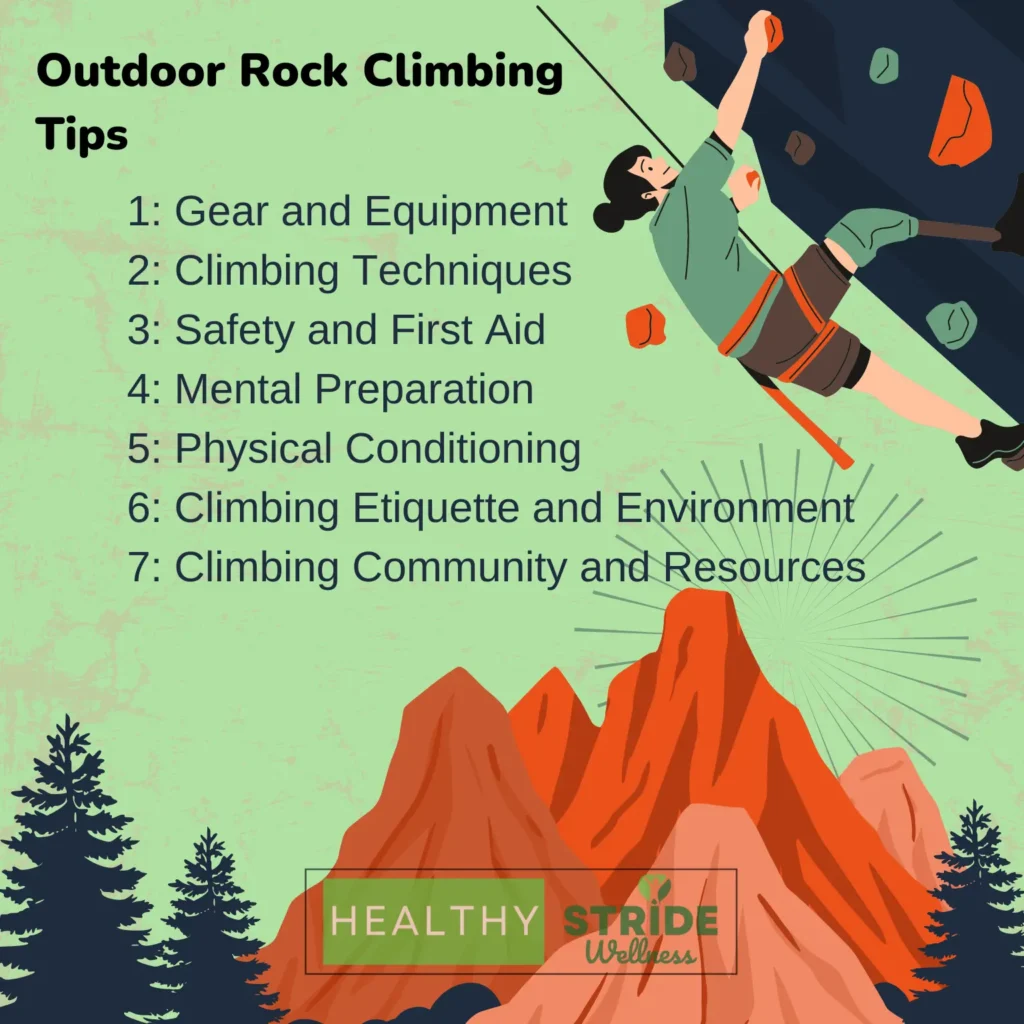
In Conclusion
Outdoor rock climbing offers an incredible opportunity to challenge yourself physically and mentally while immersing yourself in nature’s beauty. By following these essential tips, you can enhance your safety, enjoyment, and overall climbing experience. Remember, progress takes time, so be patient, persistent, and passionate about your climbing journey.
Healthy Stride Wellness encourages you to embrace the adventure, explore new climbing areas, and connect with fellow climbers. We’re thrilled to join you on your climbing adventure!
Follow Healthy Stride Wellness for more insights and tips on living a healthy and active lifestyle. Do check our other article to learn more on our website.
FAQs
Is rock climbing a dangerous sport?
While rock climbing carries inherent risks, with proper training, equipment, and safety measures, the risks can be significantly minimized. Accidents can happen, but focusing on safety and building your skills gradually can help you enjoy the sport safely.
What is the best age to start rock climbing?
There’s no definitive age to start outdoor rock climbing. Many climbing gyms offer programs for children as young as five or six. However, it’s essential to choose age-appropriate climbs and prioritize safety at all times.
Are you wondering if you have to be in good shape to begin rock climbing?
A: While physical fitness is beneficial, you don’t need to be an athlete to start rock climbing. Climbing builds strength and endurance over time. Beginners can start with easier climbs and gradually increase the intensity as they progress.
Please Note: Healthy Stride Wellness provides educational content and is not a replacement for medical advice. Consult a healthcare provider for any health issues.

